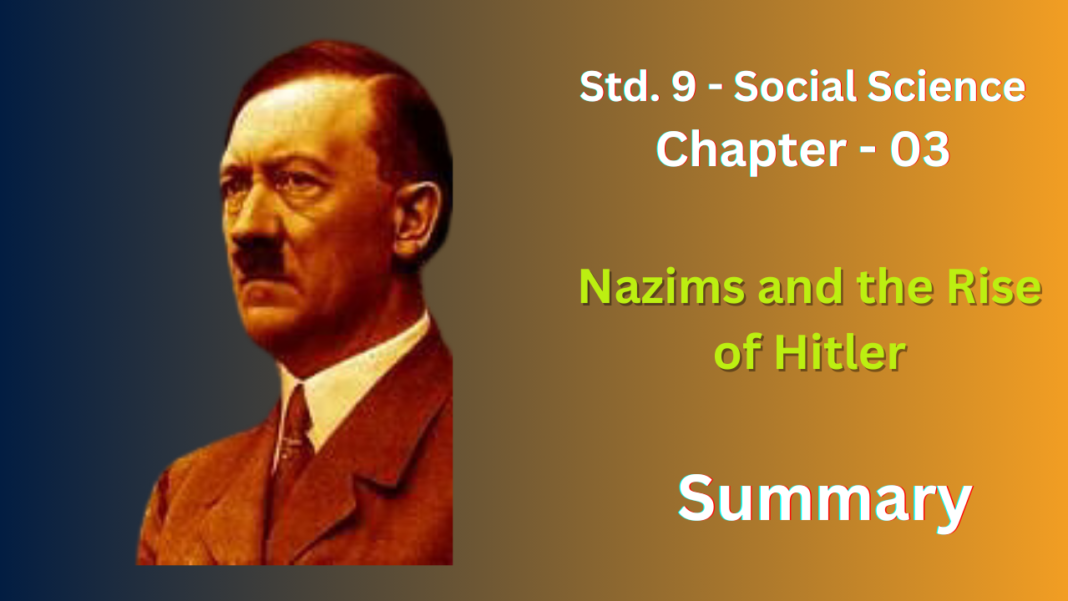NCERT Solutions for Class 9 History Chapter 3
This chapter likely explores the rise of Adolf Hitler and the Nazi Party in Germany during the early 20th century. Here’s a concise breakdown:
Germany After World War I:
- Defeat and Humiliation: Germany’s defeat in World War I led to a deep sense of national humiliation and economic hardship.
- The Treaty of Versailles: The harsh terms imposed on Germany by the Treaty of Versailles fueled resentment and a desire for revenge.
Rise of Discontent:
- Political Instability: The Weimar Republic, the new democratic government of Germany, faced numerous challenges and struggled to maintain stability.
- Economic Crisis: The Great Depression in the late 1920s further worsened Germany’s economic situation, leading to widespread unemployment and poverty.
Enter Hitler and the Nazis:
- The National Socialist German Workers’ Party (Nazi Party): Hitler, a charismatic but hateful speaker, rose to prominence as the leader of the Nazi Party.
- Nazi Ideology: The Nazis preached a racist and ultranationalist ideology. They blamed Germany’s problems on Jews, communists, and other minorities. They promised to restore German pride and create a pure Aryan race.
Appealing to the Discontented:
- Propaganda: The Nazis used effective propaganda to spread their message and scapegoat minorities. They appealed to the anxieties and frustrations of the German people.
- Promises of Prosperity: The Nazis promised to restore German greatness, create jobs, and rebuild the nation’s economy.
Hitler’s Rise to Power:
- Exploiting Instability: The Nazis exploited the political and economic instability to gain popularity. They participated in elections and gradually increased their power.
- Appointment as Chancellor: In 1933, Hitler was appointed Chancellor of Germany. This marked a turning point, as he quickly consolidated power and established a dictatorship.
The Legacy:
- Persecution and War: The Nazi regime persecuted Jews, Roma (Gypsies), homosexuals, and other minorities, culminating in the Holocaust, a horrific genocide. Hitler’s aggressive foreign policy led to World War II, a devastating global conflict.
- A Warning for the Future: The rise of the Nazis and the horrors they committed serve as a stark reminder of the dangers of racism, extremism, and unchecked nationalism.
NCERT Solutions for Class 9 History Chapter 3
Exercise
1. Describe the problems faced by the Weimar Republic.
Ans : The Weimar Republic, established in Germany after World War I, faced a multitude of problems from its inception, making it a precarious democracy:
Political Instability:
- Fragmented Government: The Weimar Republic had a weak coalition government with numerous political parties, making it difficult to pass legislation and maintain stability.
- Proportional Representation: The proportional representation system, while ensuring representation for various groups, often led to fractured parliaments with no clear majority, further hindering effective governance.
- Radical Fringe: Both communist and right-wing extremist groups challenged the Republic’s legitimacy, creating an atmosphere of political tension and violence.
Economic Hardship:
- Treaty of Versailles: The crippling reparations imposed by the Treaty of Versailles burdened the German economy, leading to hyperinflation and a decline in living standards.
- Great Depression: The global economic crisis of the 1930s further devastated Germany, causing widespread unemployment and social unrest.
Social Discontent:
- Humiliation of Defeat: The German people felt humiliated by their defeat in World War I and resented the Treaty’s terms. This fueled anger and a desire for a strong leader to restore national pride.
- Loss of Territory: The Treaty forced Germany to cede territories, displacing people and creating resentment among citizens.
- Disillusionment with Democracy: Many Germans, facing economic hardship and political instability, became disillusioned with the Weimar Republic’s democratic system.
2. Discuss why Nazism became popular in Germany by 1930.
Ans : The rise of Nazism in Germany wasn’t a simple phenomenon. It was a confluence of factors that created a fertile ground for Hitler’s hateful ideology to take root. Here’s a breakdown of the key reasons why Nazism gained popularity by 1930:
Political and Economic Instability:
- Weimar Republic’s Struggles: The Weimar Republic, established after Germany’s defeat in World War I, faced numerous challenges. Fragile coalition governments, a proportional representation system leading to fractured parliaments, and constant threats from communist and right-wing extremists created a sense of political chaos.
- Economic Hardship: The Treaty of Versailles imposed heavy reparations on Germany, crippling its economy. This burden, coupled with the Great Depression in the late 1920s, led to hyperinflation, unemployment, and social unrest. This economic misery left many Germans desperate for change.
Humiliation and Resentment:
- Defeat in World War I: Germans felt deeply humiliated by their defeat in the war. The Treaty of Versailles, seen as a harsh punishment, further fueled resentment and a desire for revenge. This nationalistic fervor made them susceptible to the Nazi scapegoating of minorities, particularly Jews.
- Loss of Territory: The Treaty forced Germany to cede territories, displacing people and creating a sense of national disunity. This fed into the Nazi rhetoric of restoring German pride and reclaiming lost glory.
Hitler’s Propaganda and Charisma:
- Effective Messaging: The Nazi Party, led by Adolf Hitler, waged a powerful propaganda campaign. They used rallies, speeches, and media to spread their message of national renewal, blaming Germany’s woes on Jews, communists, and other minorities. Hitler, a skilled speaker, tapped into the public’s anxieties and frustrations, promising to restore German greatness and prosperity.
- Scapegoating Minorities: The Nazis offered a simple explanation for Germany’s problems by scapegoating minorities, particularly Jews. This tactic played on pre-existing prejudices and anxieties, uniting some Germans behind a common enemy.
Disillusionment with Democracy:
- Failed Democracy: Many Germans, facing economic hardship and political instability, became disillusioned with the Weimar Republic’s democratic system. They saw it as weak and incapable of solving Germany’s problems. This created an opening for the Nazis, who promised a strong leader and a return to national greatness.
3. What are the peculiar features of Nazi thinking?
Ans :
Racial Supremacy: At its core, Nazism was obsessed with race. The Nazis believed in the superiority of the “Aryan race,” a pseudo-scientific concept referring to Nordic Germans with blond hair and blue eyes. They viewed all other races, particularly Jews and Slavs, as inferior and destined to be subjugated or eliminated.
Antisemitism: Jews were the primary target of Nazi hatred. They were blamed for Germany’s problems, cast as outsiders and a threat to the purity of the Aryan race. This prejudice culminated in the horrific Holocaust, the systematic extermination of Jews across Europe.
Lebensraum (“Living Space”): The Nazis believed Germany needed more Lebensraum (living space) to accommodate the supposedly superior Aryan race. This expansionist ideology fueled their aggressive foreign policy and territorial ambitions, ultimately leading to World War II.
Totalitarianism: The Nazi regime aimed for complete control over every aspect of German life. Individual freedoms were suppressed, and blind obedience to Hitler and the Nazi Party was demanded. Propaganda, censorship, and a brutal police state ensured conformity and crushed dissent.
Cult of Personality: Hitler was worshipped as a charismatic leader and infallible savior of the German nation. Nazi propaganda portrayed him as a strongman who could restore Germany’s greatness. This blind devotion to Hitler allowed him to consolidate absolute power and orchestrate horrific crimes.
Social Darwinism: The Nazis twisted Darwin’s theory of evolution to justify their racial ideology. They believed in the “survival of the fittest” on a racial level, using it to legitimize their domination and the extermination of “inferior” races.
4. Explain why Nazi propaganda was effective in creating a hatred for Jews.
Ans :
Nazi propaganda was chillingly effective in creating hatred for Jews by exploiting a combination of factors:
Pre-Existing Prejudice:
- Antisemitism in Europe: Anti-Jewish prejudice had existed in Europe for centuries. Nazi propaganda tapped into these existing biases, portraying Jews as outsiders, untrustworthy, and responsible for Germany’s woes.
Scapegoating and Dehumanization:
- Blaming Jews for Problems: The Nazis blamed Jews for Germany’s defeat in World War I, the economic crisis, and other national misfortunes. This constant barrage of accusations painted Jews as the enemy within.
- Dehumanizing Language: Propaganda used dehumanizing language like “vermin” and “rats” to refer to Jews, stripping them of their humanity and making violence against them seem acceptable.
Visual Propaganda and Stereotypes:
- Caricatures and Posters: Nazi propaganda heavily relied on visual imagery. Caricatures of Jews with exaggerated features reinforced negative stereotypes and fueled hatred. Posters portrayed Jews as greedy, manipulative, and a threat to German purity.
Control of Media and Education:
- Censorship and Manipulation: The Nazis tightly controlled all forms of media, ensuring only their message reached the public. Educational institutions were indoctrinated with Nazi ideology, further normalizing antisemitism among the younger generation.
Exploiting Fear and Emotions:
- Nationalism and Insecurity: Propaganda played on feelings of national pride and insecurity after Germany’s defeat. It portrayed Jews as a threat to German identity and national renewal, stoking fear and resentment.
Social Pressures and Conformity:
- Creating an “Us vs. Them” Mentality: Propaganda fostered a strong sense of in-group belonging among Germans. It pressured people to conform and ostracized those who questioned Nazi ideology, creating a climate of fear and silence.
Fake News and Fabricated Stories:
- The “Protocols of the Elders of Zion”: The Nazis spread fabricated documents like “The Protocols of the Elders of Zion,” which falsely claimed a Jewish conspiracy to control the world. This “evidence” fueled paranoia and hatred.
5. Explain what role women had in Nazi society. Return to Chapter 1 on the French Revolution. Write a paragraph comparing and contrasting the role of women in the two periods.
Ans : Women in Nazi Germany vs. French Revolution: Contrasting Roles
Nazi Germany:
- Confined to Domestic Sphere: Nazi ideology viewed women primarily as mothers responsible for bearing and raising pure Aryan children. Their motto was “Kinder, Küche, Kirche” (Children, Kitchen, Church). Women were discouraged from pursuing higher education or careers.
- Propaganda and Incentives: Propaganda glorified motherhood and large families. The government awarded mothers with many children medals like the “Mother’s Cross.”
French Revolution:
- Active Participation: Women actively participated in the revolution. They marched in protests, demanded political rights, and even formed their own political clubs.
- Fight for Equality: Women like Olympe de Gouges wrote scathing critiques of the exclusion of women from citizenship and demanded equal rights with men.
Contrasting Roles:
The role of women in Nazi Germany and the French Revolution stands in stark contrast. Nazi ideology actively confined women to the domestic sphere, while the French Revolution saw women actively fighting for social and political equality. The Nazi regime valued women for their reproductive potential, while the French Revolution recognized women’s intellectual and political contributions.
6. In what ways did the Nazi state seek to establish total control over its people?
Ans : The Nazis ruled with an iron fist, using propaganda, censorship, and a brutal police state (Gestapo) to silence dissent. Education and youth groups indoctrinated the young, while control of media and culture ensured only the Nazi message was heard. Social life was monitored, and the economy geared towards war. Fear, nationalism, and racism fueled this oppressive machinery.
NCERT Solutions for Class 9 History Chapter 3
FAQ’s
Who were the key figures mentioned in Class 9 History Chapter 3?
The key figure is Adolf Hitler, the leader of the Nazi Party. Other important figures include Joseph Goebbels, Heinrich Himmler, and Hermann Göring, who played significant roles in the Nazi regime.
What significant events are highlighted in NCERT solutions for Class 9 History Chapter 3?
Significant events include Hitler’s rise to power in 1933, the passing of the Nuremberg Laws, the Kristallnacht (Night of Broken Glass), and the beginning of World War II in 1939.
What was the impact of Nazi policies on German society according to Class 9 History Chapter 3?
Nazi policies led to the persecution of Jews and other minorities, the establishment of a totalitarian state, the promotion of aggressive nationalism, and the militarization of German society.
What were the Nuremberg Laws and their significance as discussed in Class 9 History Chapter 3?
The Nuremberg Laws, passed in 1935, were anti-Semitic laws that stripped Jews of their citizenship and legal rights, marking a significant step towards the systemic persecution and marginalization of Jewish people in Nazi Germany.
How did the Treaty of Versailles contribute to the rise of Hitler as described in Class 9 History Chapter 3?
The Treaty of Versailles imposed harsh penalties on Germany, leading to economic hardship and national humiliation. This created a fertile ground for Hitler’s nationalist and revanchist rhetoric, which resonated with the disgruntled populace.
What is covered in Class 9 History Chapter 3?
Class 9 History Chapter 3 covers the topic of Nazism and the Rise of Hitler. It explores the socio-economic and political conditions in Germany after World War I, the rise of Adolf Hitler and the Nazi Party, and the impact of Nazi policies on Germany and the world.
How do the NCERT solutions for Class 9 History Chapter 3 help students?
The NCERT solutions for Class 9 History Chapter 3 provide detailed explanations and answers to textbook questions, helping students understand the key concepts, events, and figures related to the rise of Nazism and Hitler.









